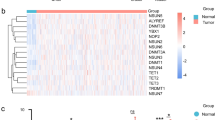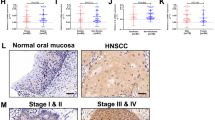Abstract
Signal transducer and activator of transcription 3 (STAT3) overactivation is a common event in many cancers, including head and neck squamous cell carcinoma (HNSCC), where STAT3 represents a promising therapeutic target. HNSCC is not characterized by frequent kinase mutations, in contrast to some malignancies where mutational activation of kinases upstream of STAT3 is common. Instead, STAT3 may be activated by loss-of-function of negative regulators of STAT3, including by promoter hypermethylation of PTPRT. Here we first analyzed The Cancer Genome Atlas data and determined that the PTPRT promoter is frequently hypermethylated in several cancers, including HNSCC (60.1% of tumors analyzed) in association with downregulation of PTPRT mRNA expression and upregulation of pSTAT3 expression. These findings were confirmed in an independent cohort of HNSCC tumors by methylation-specific PCR and immunohistochemistry. We demonstrate that PTPRT promoter methylation and gene silencing is reversible in HNSCC cells, leading to PTPRT-specific downregulation of pSTAT3 expression. We further show that PTPRT promoter methylation is significantly associated with sensitivity to STAT3 inhibition in HNSCC cells, suggesting that PTPRT promoter methylation may serve as a predictive biomarker for responsiveness to STAT3 inhibitors in clinical development.
This is a preview of subscription content, access via your institution
Access options
Subscribe to this journal
Receive 50 print issues and online access
$259.00 per year
only $5.18 per issue
Buy this article
- Purchase on Springer Link
- Instant access to full article PDF
Prices may be subject to local taxes which are calculated during checkout






Similar content being viewed by others
References
Siegel R, Ma J, Zou Z, Jemal A . Cancer statistics, 2014. CA Cancer J Clin 2014; 64: 9–29.
Peyser ND, Grandis JR . Critical analysis of the potential for targeting STAT3 in human malignancy. OncoTargets Ther 2013; 6: 999.
Julien S, Dubé N, Hardy S, Tremblay M . Inside the human cancer tyrosine phosphatome. Nat Rev Cancer 2011; 11: 35–49.
Lui VWY, Peyser ND, Ng PK-S, Hritz J, Zeng Y, Lu Y et al. Frequent mutation of receptor protein tyrosine phosphatases provides a mechanism for STAT3 hyperactivation in head and neck cancer. Proc Natl Acad Sci USA 2014; 111: 1114–1119.
Zhang X, Guo A, Yu J, Possemato A, Chen Y, Zheng W et al. Identification of STAT3 as a substrate of receptor protein tyrosine phosphatase T. Proc Natl Acad Sci USA 2007; 104: 4060–4064.
Benson E, Li R, Eisele D, Fakhry C . The clinical impact of HPV tumor status upon head and neck squamous cell carcinomas. Oral Oncol 2014; 50: 565–574.
Leemans CR, Braakhuis BJ, Brakenhoff RH . The molecular biology of head and neck cancer. Nat Rev Cancer 2011; 11: 9–22.
Licitra L, Mesia R, Rivera F, Remenár E, Hitt R, Erfán J et al. Evaluation of EGFR gene copy number as a predictive biomarker for the efficacy of cetuximab in combination with chemotherapy in the first-line treatment of recurrent and/or metastatic squamous cell carcinoma of the head and neck: EXTREME study. Ann Oncol 2011; 22: 1078–1087.
Sen M, Joyce S, Panahandeh M, Li C, Thomas SM, Maxwell J et al. Targeting Stat3 abrogates EGFR inhibitor resistance in cancer. Clin Cancer Res 2012; 18: 4986–4996.
Laczmanska I, Karpinski P, Bebenek M, Sedziak T, Ramsey D, Szmida E et al. Protein tyrosine phosphatase receptor-like genes are frequently hypermethylated in sporadic colorectal cancer. J Hum Genet 2013; 58: 11–15.
Gao W, Kondo Y, Shen L, Shimizu Y, Sano T, Yamao K et al. Variable DNA methylation patterns associated with progression of disease in hepatocellular carcinomas. Carcinogenesis 2008; 29: 1901–1910.
Li L-C, Dahiya R . MethPrimer: designing primers for methylation PCRs. Bioinformatics 2002; 18: 1427–1431.
Ji T, Gong D, Han Z, Wei X, Yan Y, Ye F et al. Abrogation of constitutive Stat3 activity circumvents cisplatin resistant ovarian cancer. Cancer Lett 2013; 341: 231–239.
Acknowledgements
This work was supported by the National Cancer Institute at the National Institutes of Health (grant numbers P50 CA097190 and R01 CA077308 to JRG); and by the National Institute for Dental and Craniofacial Research at the National Institutes of Health (grant number F31 DE024007 to NDP). The authors wish to thank Mark H Gage for technical assistance.
Author information
Authors and Affiliations
Corresponding author
Ethics declarations
Competing interests
The authors declare no conflict of interest.
Additional information
Supplementary Information accompanies this paper on the Oncogene website
Rights and permissions
About this article
Cite this article
Peyser, N., Freilino, M., Wang, L. et al. Frequent promoter hypermethylation of PTPRT increases STAT3 activation and sensitivity to STAT3 inhibition in head and neck cancer. Oncogene 35, 1163–1169 (2016). https://doi.org/10.1038/onc.2015.171
Received:
Revised:
Accepted:
Published:
Issue Date:
DOI: https://doi.org/10.1038/onc.2015.171
This article is cited by
-
Downregulation of PTPRT elevates the expression of survivin and promotes the proliferation, migration, and invasion of lung adenocarcinoma
BMC Cancer (2024)
-
First genome-wide association study of non-severe malaria in two birth cohorts in Benin
Human Genetics (2019)
-
Targeting the IL-6/JAK/STAT3 signalling axis in cancer
Nature Reviews Clinical Oncology (2018)
-
Identification of subsets of actionable genetic alterations in KRAS-mutant lung cancers using association rule mining
Cellular Oncology (2018)
-
Mechanism of action of selective inhibitors of IL-6 induced STAT3 pathway in head and neck cancer cell lines
Journal of Chemical Biology (2017)



